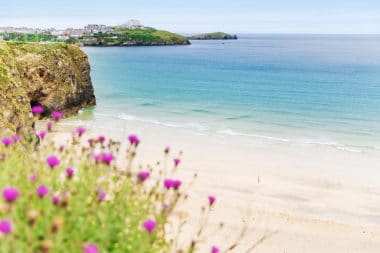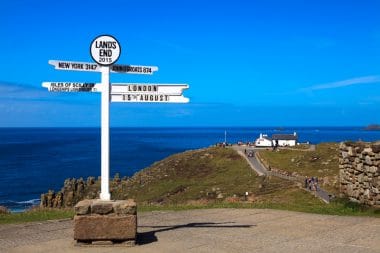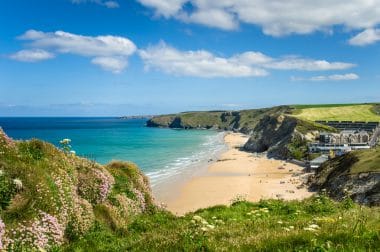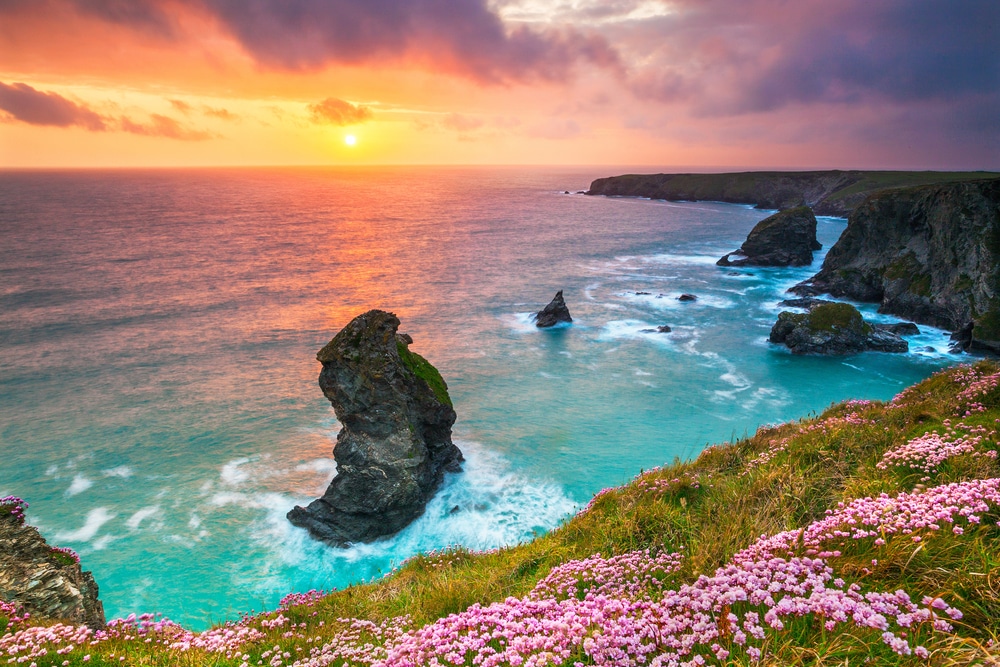Cornwall, the county in the far southwest of Great Britain, is known on the one hand for its past as a smuggler’s paradise, as a supplier of tin, porcelain clay (kaolin) and as a film location for Rosamunde Pilcher films or the series Poldark.
On the other hand, Cornwall is also known for its breathtaking landscape, with fantastic beaches, turquoise blue water, idyllic fishing villages and meter-high cliffs where the Atlantic waves break. In short, a beautiful holiday resort that offers everything for both the nature lover with or without a dog, artist, beach lover or athlete.
From Arthurian legend to star chef – the northwest of Cornwall

No country manages this balancing act between modernity and history better than Great Britain. In Cornwall, you can feel this mix, meant positively, with full force.
The North West of Cornwall is lined with a rugged and rugged coastline dotted with many small historic fishing villages. Whether Boscastle or Port Isaac, you can immediately feel the long tradition of fishing here.
Between these two places is the historical origin of the Arthurian legend – Tintagle Castle with the alleged birthplace of King Arthur, who was raised by Merlin the Great Magician. High above the Atlantic Ocean, the ruins of Tintagle Castle stretch across two headlands connected by a spectacular new suspension bridge.
A few kilometers further south, a magician of modern times is at home. Rick Stein, the famous British star chef, has set up shop in Padstow with several top restaurants and shows there that British cuisine is much better than its reputation.
Surfing, beach and art
If you drive further south, Newquay (pronounced New-Key) is one of the surfer hotspots in Europe. The elongated waves and rough cliffs offer perfect conditions for all water sports enthusiasts and Fistral Beach and Watergate Bay host international surfing events every year.
As the motherland of golf, there are of course also numerous golf courses, some with spectacular views of the coast and the sea.

The St. Agnes Heritage Cove invites you to a relaxing excursion with the town of St. Agnes of the same name. Trevaunance Cove is an absolute highlight.
From there, head to St Ives, known for the Tate art museum. With beautiful and long beaches, St Ives offers a feeling that is more reminiscent of the Caribbean than England. For art lovers, the Tate and numerous galleries offer plenty of material to linger, while beach lovers chill out under palm trees on the beach and eat delicious Cornish ice cream.
The South – the end of Great Britain

The south has two end points in Great Britain. Namely, Land’s End, the southwesternmost point, and Lizard Point, the southernmost point of Great Britain. Both sights should not be missed on any trip, as they offer completely different landscapes.
The southwest is characterized by its long history as a tin mining area. Ancient ruins and chimneys line the Penwith Heritage Coast, transporting you to a fantasy world.If you’re looking for artistic entertainment, plan a visit to the Minack Theatre. The amphitheatre, carved into the rocky coast, convinces with a varied theatre programme and indescribable views.
In addition, St. Michael’s Mount, a castle on an island that can be reached during low tide via a paved path, is one of Cornwall’s most famous landmarks. Cute fishing villages such as Porthleven, Mousehole or Marazion invite you to linger. On the Lizard Peninsula, you should definitely have Mullion Cove, Kynance Cove, Lizard Point and Cadgwith on your itinerary.
For garden lovers, a visit to the Eden Project is a must. Here, the English archaeologist and garden lover Tim Smit has created a botanical garden that is unparalleled in Europe. In two large geodesic domes, he has created greenhouses that depict plants from different climate zones. The Eden Project also includes The Lost Gardens of Heligans, a few kilometres away. On over 400 hectares, there is something for every taste on the spacious grounds.
The Southeast – the hidden diamond

The south-east of Cornwall is commonly referred to as the hidden diamond. At first glance, the coastline is not as spectacular as the north or southwest coast, but with its numerous beaches, bays and estuaries, it convinces all along the line.
If you have planned some time, we recommend a hike along the Coastal Path to St. Anthony Head. The view of the bay of Falmouth, protected by the old fortifications, is magical.
St Mawes, Mevagissey or Falmouth are interesting stops on this section. Lovers of historic ships stop in Charlestown and get their money’s worth there. Fowey, a picture-perfect town, Looe and Polperro are also highly recommended towns on this route. If you drive further east, you will slowly come to the eastern border of Cornwall before crossing it at Plymouth towards the county of Devon. Shortly before that, however, it is worth taking a detour to the Rame Head Heritage Coast and Mount Edgcumbe House and Country Park with a beautiful view of Plymouth Bay.
Where to sleep in Cornwall?
Since Cornwall is not only popular with the British as a holiday destination, there are numerous places to stay in Cornwall. From holiday homes and apartments, glamping and camping offers to bed & breakfast, there is the right accommodation for every wish and every budget. During the high season, which runs from the end of June to the end of August, you should definitely make a reservation in advance.
Cornwall is always worth a visit
The best time to travel to Cornwall for me is May to mid-June or mid-September to early October. This way you can avoid the peak travel season, find cheap accommodation offers and enjoy the tranquility of Cornwall to the fullest.
The guest post was written by Nick from the travel blog “Cornwall & Meer” (
https://cornwall-meer.de
). Nick has been travelling regularly to Cornwall for 10 years and enjoys renting holiday homes there. He writes about his experiences on his travel blog and shares his tips and tricks for Cornwall with his readers.


